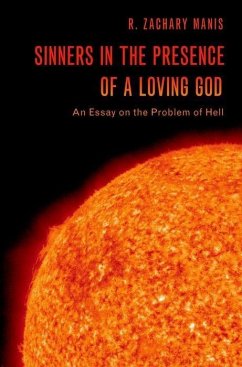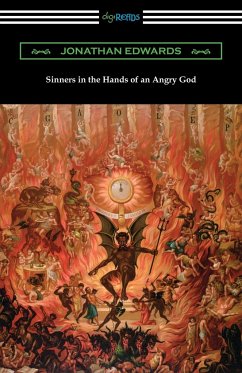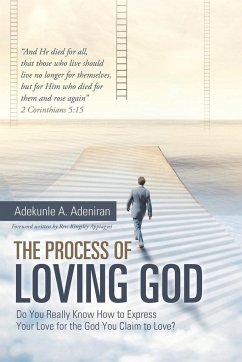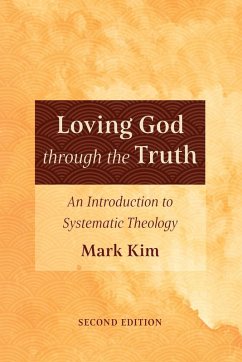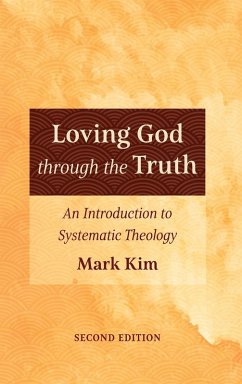- Gebundenes Buch
- Merkliste
- Auf die Merkliste
- Bewerten Bewerten
- Teilen
- Produkt teilen
- Produkterinnerung
- Produkterinnerung
In Sinners in the Presence of a Loving God, R. Zachary Manis examines in detail the several facets of the problem of hell, considers the reasons why the usual responses to the problem are unsatisfying, and suggests how an adequate solution to the problem can be constructed.
Andere Kunden interessierten sich auch für
![Grace Abounding to the Chief of Sinners (Royal Collector's Edition) (Case Laminate Hardcover with Jacket) Grace Abounding to the Chief of Sinners (Royal Collector's Edition) (Case Laminate Hardcover with Jacket)]() John BunyanGrace Abounding to the Chief of Sinners (Royal Collector's Edition) (Case Laminate Hardcover with Jacket)40,99 €
John BunyanGrace Abounding to the Chief of Sinners (Royal Collector's Edition) (Case Laminate Hardcover with Jacket)40,99 €![Sinners in the Hands of an Angry God Sinners in the Hands of an Angry God]() Jonathan EdwardsSinners in the Hands of an Angry God9,49 €
Jonathan EdwardsSinners in the Hands of an Angry God9,49 €![The Process of Loving God The Process of Loving God]() Adekunle A. AdeniranThe Process of Loving God12,99 €
Adekunle A. AdeniranThe Process of Loving God12,99 €![Loving God through the Truth, Second Edition Loving God through the Truth, Second Edition]() Mark KimLoving God through the Truth, Second Edition44,99 €
Mark KimLoving God through the Truth, Second Edition44,99 €![Lifting the Veil of Evil That Hides a Loving God Lifting the Veil of Evil That Hides a Loving God]() Branka VukshichLifting the Veil of Evil That Hides a Loving God14,99 €
Branka VukshichLifting the Veil of Evil That Hides a Loving God14,99 €![Loving God through the Truth, Second Edition Loving God through the Truth, Second Edition]() Mark KimLoving God through the Truth, Second Edition57,99 €
Mark KimLoving God through the Truth, Second Edition57,99 €![Sinners in the Hands of an Angry God Sinners in the Hands of an Angry God]() Jonathan EdwardsSinners in the Hands of an Angry God21,99 €
Jonathan EdwardsSinners in the Hands of an Angry God21,99 €-
-
-
In Sinners in the Presence of a Loving God, R. Zachary Manis examines in detail the several facets of the problem of hell, considers the reasons why the usual responses to the problem are unsatisfying, and suggests how an adequate solution to the problem can be constructed.
Produktdetails
- Produktdetails
- Verlag: Oxford University Press
- Seitenzahl: 434
- Erscheinungstermin: 1. Juli 2019
- Englisch
- Abmessung: 236mm x 165mm x 41mm
- Gewicht: 726g
- ISBN-13: 9780190929251
- ISBN-10: 0190929251
- Artikelnr.: 56750799
- Herstellerkennzeichnung
- Libri GmbH
- Europaallee 1
- 36244 Bad Hersfeld
- gpsr@libri.de
- Verlag: Oxford University Press
- Seitenzahl: 434
- Erscheinungstermin: 1. Juli 2019
- Englisch
- Abmessung: 236mm x 165mm x 41mm
- Gewicht: 726g
- ISBN-13: 9780190929251
- ISBN-10: 0190929251
- Artikelnr.: 56750799
- Herstellerkennzeichnung
- Libri GmbH
- Europaallee 1
- 36244 Bad Hersfeld
- gpsr@libri.de
R. Zachary Manis (Ph.D., Baylor) is Professor of Philosophy at Southwest Baptist University. He is the co-author, with C. Stephen Evans, of Philosophy of Religion: Thinking About Faith, Second Edition. Manis lives in Bolivar, Missouri, with his wife Lisa and three children, Solomon, Nora, and Emmaline.
Acknowledgments
Introduction
Criteria for an Adequate Solution
Theodicy vs. Defense
Part I: Developing the Problem
Chapter One: The Problem of Justice, The Problem of Love
The Problem of Justice
An Uncommon Solution: Shedd
The Popular Response: Aquinas
A Revised Version of the Response
Problems for the Revised Response
An Alternative Strategy: Denying that God Has Obligations
Remaining Options
The Problem of Love
Chapter Two: The Doxastic Problem
Preliminaries
Doxastic Problems
The Problem of Coercion
The Problem of Neighbor Love
The Problem of Worship
The Problem of Religious Motivation
The Problem of Despair
Addendum: Additional Problems for Calvinists and Other Theological Determinists
The Extreme Version of the Problem of Justice
The Extreme Version of the Problem of Love
Further Doxastic Problems
The Problem of Faith
The Problem of Hope
Part II: The Standard Options
Chapter Three: Traditionalism and Universalism
Traditionalism
Universalism
The Case for Universalism
Talbott on Love and Justice
Adams on Horrendous Evil and the Metaphysical "Size Gap"
Chapter Four: Providence, Freedom, and God's Creation of the Damned
The Free Will Argument against Universalism
Molinism and Universalism
Why Does God Create the Damned?
Molinist Anti-Universalism (M-AU)
A Nonstandard Account of Providence: McCann
Open Theist Anti-Universalism (OT-AU)
The Tradition Trilemma
Why Not Universalism?
Chapter Five: Annihilationism
Internal Disputes
Retributive Annihilationism
Non-Retributive Annihilationism
Natural Consequence Annihilationism (NCA)
Objections to NCA
Free Will Annihilationism (FWA)
Objections to FWA
Chapter Six: The Choice Model
The Direct Form
Help from Kierkegaard
The Role of Self-Deception
The Indirect Form
More Help from Kierkegaard
Why Not Annihilation?
Answer #1: Annihilation as Undesirable to the Damned
Answer #2: Annihilation as Indefeasibly Bad
Answer #3: The Soul as Inherently Indestructible
Answer #4: Humans as Essentially Immortal
In Defense of the Kierkegaardian Answer
Why Not the Choice Model?
Part III: The Divine Presence Model
Chapter Seven: Developing an Alternative to the Standard Options
Return to the Tripartite Structure
Introducing the Divine Presence Model
Help from Eastern Orthodoxy
Divine Omnipresence and Divine Hiddenness
Divine Hiddenness as Necessary for Human Freedom
Divine Hiddenness as a Natural Consequence of Sin
Hiddenness on the Divine Presence Model
The Phenomenology of Religious Experience and the Fear of the Lord
Retribution and Eternal Punishment
Chapter Eight: Objections, Replies, and Further Refinements
Addressing Standard and Shared Problems
Solutions in Common with the Choice Model
A (Possible) Point of Difference
Why Not Annihilation?
Why Not Eternal Divine Hiddenness?
Hybrid Views
Baker
Lewis
Kvanvig
Walls
Talbott
The Inescapable Love of God
Conclusion
Beyond the Day of Judgment
Appendix: Is the Divine Presence Model Biblical?
The Scriptural Record of Close Encounters with God
Christ the Way
Unveiling the Heart
The Face of God
Christ the Truth
Jesus and the Pharisees
Light and Darkness
Does Christ Come to Judge, or Not?
Christ the Life
The Curse of Death
The Destruction of Hades
The River of Fire and the River of Life
Bibliography
Index
Introduction
Criteria for an Adequate Solution
Theodicy vs. Defense
Part I: Developing the Problem
Chapter One: The Problem of Justice, The Problem of Love
The Problem of Justice
An Uncommon Solution: Shedd
The Popular Response: Aquinas
A Revised Version of the Response
Problems for the Revised Response
An Alternative Strategy: Denying that God Has Obligations
Remaining Options
The Problem of Love
Chapter Two: The Doxastic Problem
Preliminaries
Doxastic Problems
The Problem of Coercion
The Problem of Neighbor Love
The Problem of Worship
The Problem of Religious Motivation
The Problem of Despair
Addendum: Additional Problems for Calvinists and Other Theological Determinists
The Extreme Version of the Problem of Justice
The Extreme Version of the Problem of Love
Further Doxastic Problems
The Problem of Faith
The Problem of Hope
Part II: The Standard Options
Chapter Three: Traditionalism and Universalism
Traditionalism
Universalism
The Case for Universalism
Talbott on Love and Justice
Adams on Horrendous Evil and the Metaphysical "Size Gap"
Chapter Four: Providence, Freedom, and God's Creation of the Damned
The Free Will Argument against Universalism
Molinism and Universalism
Why Does God Create the Damned?
Molinist Anti-Universalism (M-AU)
A Nonstandard Account of Providence: McCann
Open Theist Anti-Universalism (OT-AU)
The Tradition Trilemma
Why Not Universalism?
Chapter Five: Annihilationism
Internal Disputes
Retributive Annihilationism
Non-Retributive Annihilationism
Natural Consequence Annihilationism (NCA)
Objections to NCA
Free Will Annihilationism (FWA)
Objections to FWA
Chapter Six: The Choice Model
The Direct Form
Help from Kierkegaard
The Role of Self-Deception
The Indirect Form
More Help from Kierkegaard
Why Not Annihilation?
Answer #1: Annihilation as Undesirable to the Damned
Answer #2: Annihilation as Indefeasibly Bad
Answer #3: The Soul as Inherently Indestructible
Answer #4: Humans as Essentially Immortal
In Defense of the Kierkegaardian Answer
Why Not the Choice Model?
Part III: The Divine Presence Model
Chapter Seven: Developing an Alternative to the Standard Options
Return to the Tripartite Structure
Introducing the Divine Presence Model
Help from Eastern Orthodoxy
Divine Omnipresence and Divine Hiddenness
Divine Hiddenness as Necessary for Human Freedom
Divine Hiddenness as a Natural Consequence of Sin
Hiddenness on the Divine Presence Model
The Phenomenology of Religious Experience and the Fear of the Lord
Retribution and Eternal Punishment
Chapter Eight: Objections, Replies, and Further Refinements
Addressing Standard and Shared Problems
Solutions in Common with the Choice Model
A (Possible) Point of Difference
Why Not Annihilation?
Why Not Eternal Divine Hiddenness?
Hybrid Views
Baker
Lewis
Kvanvig
Walls
Talbott
The Inescapable Love of God
Conclusion
Beyond the Day of Judgment
Appendix: Is the Divine Presence Model Biblical?
The Scriptural Record of Close Encounters with God
Christ the Way
Unveiling the Heart
The Face of God
Christ the Truth
Jesus and the Pharisees
Light and Darkness
Does Christ Come to Judge, or Not?
Christ the Life
The Curse of Death
The Destruction of Hades
The River of Fire and the River of Life
Bibliography
Index
Acknowledgments
Introduction
Criteria for an Adequate Solution
Theodicy vs. Defense
Part I: Developing the Problem
Chapter One: The Problem of Justice, The Problem of Love
The Problem of Justice
An Uncommon Solution: Shedd
The Popular Response: Aquinas
A Revised Version of the Response
Problems for the Revised Response
An Alternative Strategy: Denying that God Has Obligations
Remaining Options
The Problem of Love
Chapter Two: The Doxastic Problem
Preliminaries
Doxastic Problems
The Problem of Coercion
The Problem of Neighbor Love
The Problem of Worship
The Problem of Religious Motivation
The Problem of Despair
Addendum: Additional Problems for Calvinists and Other Theological Determinists
The Extreme Version of the Problem of Justice
The Extreme Version of the Problem of Love
Further Doxastic Problems
The Problem of Faith
The Problem of Hope
Part II: The Standard Options
Chapter Three: Traditionalism and Universalism
Traditionalism
Universalism
The Case for Universalism
Talbott on Love and Justice
Adams on Horrendous Evil and the Metaphysical "Size Gap"
Chapter Four: Providence, Freedom, and God's Creation of the Damned
The Free Will Argument against Universalism
Molinism and Universalism
Why Does God Create the Damned?
Molinist Anti-Universalism (M-AU)
A Nonstandard Account of Providence: McCann
Open Theist Anti-Universalism (OT-AU)
The Tradition Trilemma
Why Not Universalism?
Chapter Five: Annihilationism
Internal Disputes
Retributive Annihilationism
Non-Retributive Annihilationism
Natural Consequence Annihilationism (NCA)
Objections to NCA
Free Will Annihilationism (FWA)
Objections to FWA
Chapter Six: The Choice Model
The Direct Form
Help from Kierkegaard
The Role of Self-Deception
The Indirect Form
More Help from Kierkegaard
Why Not Annihilation?
Answer #1: Annihilation as Undesirable to the Damned
Answer #2: Annihilation as Indefeasibly Bad
Answer #3: The Soul as Inherently Indestructible
Answer #4: Humans as Essentially Immortal
In Defense of the Kierkegaardian Answer
Why Not the Choice Model?
Part III: The Divine Presence Model
Chapter Seven: Developing an Alternative to the Standard Options
Return to the Tripartite Structure
Introducing the Divine Presence Model
Help from Eastern Orthodoxy
Divine Omnipresence and Divine Hiddenness
Divine Hiddenness as Necessary for Human Freedom
Divine Hiddenness as a Natural Consequence of Sin
Hiddenness on the Divine Presence Model
The Phenomenology of Religious Experience and the Fear of the Lord
Retribution and Eternal Punishment
Chapter Eight: Objections, Replies, and Further Refinements
Addressing Standard and Shared Problems
Solutions in Common with the Choice Model
A (Possible) Point of Difference
Why Not Annihilation?
Why Not Eternal Divine Hiddenness?
Hybrid Views
Baker
Lewis
Kvanvig
Walls
Talbott
The Inescapable Love of God
Conclusion
Beyond the Day of Judgment
Appendix: Is the Divine Presence Model Biblical?
The Scriptural Record of Close Encounters with God
Christ the Way
Unveiling the Heart
The Face of God
Christ the Truth
Jesus and the Pharisees
Light and Darkness
Does Christ Come to Judge, or Not?
Christ the Life
The Curse of Death
The Destruction of Hades
The River of Fire and the River of Life
Bibliography
Index
Introduction
Criteria for an Adequate Solution
Theodicy vs. Defense
Part I: Developing the Problem
Chapter One: The Problem of Justice, The Problem of Love
The Problem of Justice
An Uncommon Solution: Shedd
The Popular Response: Aquinas
A Revised Version of the Response
Problems for the Revised Response
An Alternative Strategy: Denying that God Has Obligations
Remaining Options
The Problem of Love
Chapter Two: The Doxastic Problem
Preliminaries
Doxastic Problems
The Problem of Coercion
The Problem of Neighbor Love
The Problem of Worship
The Problem of Religious Motivation
The Problem of Despair
Addendum: Additional Problems for Calvinists and Other Theological Determinists
The Extreme Version of the Problem of Justice
The Extreme Version of the Problem of Love
Further Doxastic Problems
The Problem of Faith
The Problem of Hope
Part II: The Standard Options
Chapter Three: Traditionalism and Universalism
Traditionalism
Universalism
The Case for Universalism
Talbott on Love and Justice
Adams on Horrendous Evil and the Metaphysical "Size Gap"
Chapter Four: Providence, Freedom, and God's Creation of the Damned
The Free Will Argument against Universalism
Molinism and Universalism
Why Does God Create the Damned?
Molinist Anti-Universalism (M-AU)
A Nonstandard Account of Providence: McCann
Open Theist Anti-Universalism (OT-AU)
The Tradition Trilemma
Why Not Universalism?
Chapter Five: Annihilationism
Internal Disputes
Retributive Annihilationism
Non-Retributive Annihilationism
Natural Consequence Annihilationism (NCA)
Objections to NCA
Free Will Annihilationism (FWA)
Objections to FWA
Chapter Six: The Choice Model
The Direct Form
Help from Kierkegaard
The Role of Self-Deception
The Indirect Form
More Help from Kierkegaard
Why Not Annihilation?
Answer #1: Annihilation as Undesirable to the Damned
Answer #2: Annihilation as Indefeasibly Bad
Answer #3: The Soul as Inherently Indestructible
Answer #4: Humans as Essentially Immortal
In Defense of the Kierkegaardian Answer
Why Not the Choice Model?
Part III: The Divine Presence Model
Chapter Seven: Developing an Alternative to the Standard Options
Return to the Tripartite Structure
Introducing the Divine Presence Model
Help from Eastern Orthodoxy
Divine Omnipresence and Divine Hiddenness
Divine Hiddenness as Necessary for Human Freedom
Divine Hiddenness as a Natural Consequence of Sin
Hiddenness on the Divine Presence Model
The Phenomenology of Religious Experience and the Fear of the Lord
Retribution and Eternal Punishment
Chapter Eight: Objections, Replies, and Further Refinements
Addressing Standard and Shared Problems
Solutions in Common with the Choice Model
A (Possible) Point of Difference
Why Not Annihilation?
Why Not Eternal Divine Hiddenness?
Hybrid Views
Baker
Lewis
Kvanvig
Walls
Talbott
The Inescapable Love of God
Conclusion
Beyond the Day of Judgment
Appendix: Is the Divine Presence Model Biblical?
The Scriptural Record of Close Encounters with God
Christ the Way
Unveiling the Heart
The Face of God
Christ the Truth
Jesus and the Pharisees
Light and Darkness
Does Christ Come to Judge, or Not?
Christ the Life
The Curse of Death
The Destruction of Hades
The River of Fire and the River of Life
Bibliography
Index

